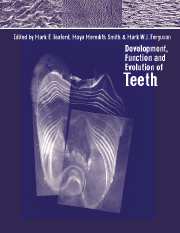Book contents
- Frontmatter
- Contents
- List of contributors
- Acknowledgements
- Part one Genes, molecules and tooth initiation
- Part two Tooth tissues: development and evolution
- Part three Evolution of tooth shape and dentition
- Part four Macrostructure and function
- 16 Developmental plasticity in the dentition of a heterodont polyphyodont fish species
- 17 Enamel microporosity and its functional implications
- 18 Pathways to functional differentiation in mammalian enamel
- 19 Trends in the evolution of molar crown types in ungulate mammals: evidence from the northern hemisphere
- 20 Function of postcanine tooth crown shape in mammals
- 21 Primate dental functional morphology revisited
- Index
18 - Pathways to functional differentiation in mammalian enamel
Published online by Cambridge University Press: 11 September 2009
- Frontmatter
- Contents
- List of contributors
- Acknowledgements
- Part one Genes, molecules and tooth initiation
- Part two Tooth tissues: development and evolution
- Part three Evolution of tooth shape and dentition
- Part four Macrostructure and function
- 16 Developmental plasticity in the dentition of a heterodont polyphyodont fish species
- 17 Enamel microporosity and its functional implications
- 18 Pathways to functional differentiation in mammalian enamel
- 19 Trends in the evolution of molar crown types in ungulate mammals: evidence from the northern hemisphere
- 20 Function of postcanine tooth crown shape in mammals
- 21 Primate dental functional morphology revisited
- Index
Summary
Introduction
Dental morphology has been the most important source of data for the interpretation of both phyletic relationships and dietary behaviors of extinct mammals. Differences in gross dental shape have traditionally contributed most of this information, although the complexity of enamel structure was recognized in the last century as subsequently were patterns of enamel microstructural differences among diverse mammalian taxa (Kawai, 1955).
However, it has only been in recent years that relationships of enamel microstructure to dental function have been identified (Walker et al., 1978; Koenigswald, 1980; Rensberger and Koenigswald, 1980; Pfretzschner, 1988; Maas, 1991). The organization of the enamel microstructure is now known to have an adaptive relationship to the stresses generated during mastication and other uses of the teeth, indicating that these structures can be used to make inferences about differences in dietary behavior in extinct taxa.
An increased interest in enamel structure in the past two decades is contributing to a greatly expanded knowledge of the microstructure. As the structures in larger numbers of taxa have been clarified, the diversity of known microstructural conditions has increased. This has resulted in an increasingly complex picture of phyletic evolution that is clearly not explained by one-to-one relationships of structure and diet. For example, some highly specialized structural conditions occur in unrelated living taxa with quite different gross dental specializations and dietary behaviors. Nevertheless, even in such cases there may be functional components that are shared and may explain the microstructural similarities.
Information
- Type
- Chapter
- Information
- Development, Function and Evolution of Teeth , pp. 252 - 268Publisher: Cambridge University PressPrint publication year: 2000
Accessibility standard: Unknown
Why this information is here
This section outlines the accessibility features of this content - including support for screen readers, full keyboard navigation and high-contrast display options. This may not be relevant for you.Accessibility Information
- 42
- Cited by
